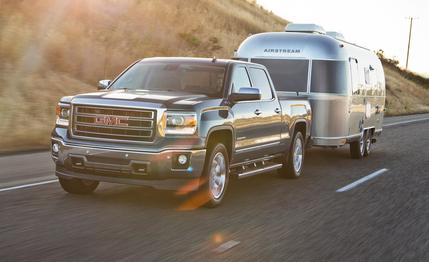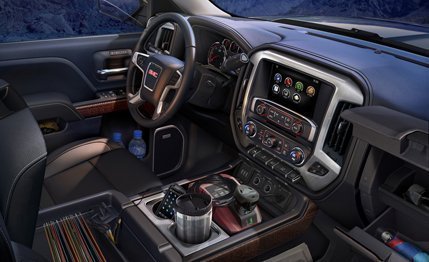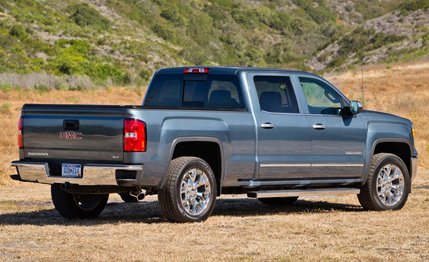 First Drive Review
First Drive Review
Identical twins can be hard to tell apart, but it gets easier when they’re wearing name tags. Maybe that’s why GM attaches big Chevrolet and GMC badges on its pickup-truck twins, the Silverado and the Sierra.
The Chevy Silverado and GMC Sierra aren’t quite identical, but engines, transmissions, chassis, and most of the sheetmetal are shared. What’s obviously different is the front-end styling. The Sierra replaces the Silverado’s stacked headlights with simpler, classier-looking small projector-beam units that are accented with LEDs on the top-dog SLT trim level. The grille, the front bumpers, the fenders, and the aluminum hood are unique to the Sierra. Black plastic trim around the fender wells and a chrome accent along the base of the side windows are more Sierra tells.
Aside from the GMC badging, the interior décor of the Sierra is, again, nearly identical to that of the bow-tie truck. Aluminum trim on all versions of the Sierra replaces what’s silver-colored in the Silverado, and wood accents are peppered throughout the top-spec SLT interiors.

Direct-Injected V-8
With those few differences, it’s not surprising that the Sierra acts just like the Silverado. The 355-hp, 5.3-liter V-8 broadcasts the same mellow V-8 soundtrack here as it does in the Chevy. Even without provoking the throttle, the 383 lb-ft of torque give an apology-worthy shove. We recently tested a Silverado LTZ crew cab equipped with the 5.3-liter, and it returned a 0-to-60 time of 6.7 seconds. We have no reason to doubt that a comparably equipped Sierra would accomplish the task in the same time.
Cruising on the highway, the 5.3 switches to V-4 mode to help save fuel. In two-wheel-drive guise, the Sierra V-8 returns an EPA-estimated 16 city mpg and 23 highway. Four-wheel-drive versions with the V-8 manage 16/22 mpg. For those interested in a little more economy at the expense of some power, there’s finally a credible V-6 option from GM. GMC hasn’t released any EPA fuel-economy estimates yet for the six; we’ll let you know as soon as it does.
Six Serious Cylinders
The standard 4.3-liter V-6 has been thoroughly redone. Not just a light nip and tuck, the engine has undergone a Michael Jackson–grade transformation. It might be distantly related to the Vortec 4300 that powered Chevy Astros and GMC Safaris when “Thriller” was still a hit, but the performance and the refinement are in line with that of 21st century V-6s. The 90-degree bank angle remains—a reminder of the engine’s V-8 roots—but it has been enhanced from top to bottom with variable-valve timing, direct fuel injection, and cylinder deactivation. Power is up by 90 horsepower, and torque rises to 305 lb-ft, an improvement of 45 lb-ft over last year’s 4.3-liter V-6. Remember the Syclone and Typhoon supertrucks? The new naturally aspirated 285-hp 4.3-liter makes five more horsepower than the turbocharged 4.3-liter V-6s could muster.

Even lugging the heavy crew-cab version, the V-6 provides what feels like sub-eight-second runs to 60 mph. Unlike the smaller-displacement V-6s from Ford and Ram, the 4.3-liter has good low-end grunt and consequently feels less strained than the competition. The car-derived Ford 3.7-liter V-6 and Ram 3.6-liter V-6 both make nearly 305 horsepower, but they fall short of the Sierra’s figure. The V-6 Sierra can tow 7200 pounds, which is 500 more than the V-6 Ford and 700 more than the V-6 Ram. This GM V-6 was designed from the git-go for truck use and is essentially a small-block Chevy V-8 with two fewer cylinders.
The rest of the Sierra experience is, not surprisingly, pure Silverado. No matter what engine is under the aluminum hood, both pickups have a quiet demeanor, an occasionally choppy but otherwise soft ride, and a smaller feel from behind the wheel than that of those big-rig-emulating competitors. The Sierra’s steering is accurate and doesn’t require constant corrections. A firm and confidence-inspiring brake pedal is almost sports-car-like, and the braking distances recorded by the Sierra’s Chevrolet analog were class-leading.
Crew cabs are arriving at dealerships now, extended-cab models soon will follow, and the regular-cab version will debut by the end of the summer. Two-wheel-drive Sierra crew cabs start at $33,210; an equivalent Silverado opens at $32,710, but the Chevy lacks a few features, such as steering-wheel audio controls and an eight-inch touch screen, that justify the cost differential. Even discounting the small bump in standard equipment, the Sierra strikes us as the more attractive of the two GM full-size pickups. If you look hard enough, one twin will always be the better-looking one.